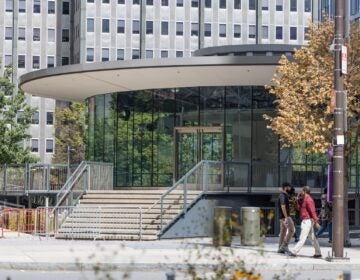Franck (Ha!) talk on the architect-client relationship

There’s a great story about the design of Shanghai’s World Financial Center, completed in 2008 and by some considerations the world’s tallest building. Although architects from Kohn Pederssem Fox initially envisioned a circular cutout at the top of the 101-story tower, the design elicited a chorus of protests because the imagery evoked the rising sun of China’s long-time rival, Japan.
This, despite — or in spite of? — the fact that the Japanese were substantial investors in the project.
I thought of the controversy as I listened to a presentation on the architect-client relationship delivered by Karen Franck, an environmental psychologist who teaches at the College of Architecture and Design at the New Jersey Institute of Technology. The lecture, “Let the Client Speak: Design Through Dialogue,” was offered last Thursday as part of Drexel Universty’s Farajollah & Maryam Badie Arfaa Lecture Series in Architecture.
The Shanghai story has always struck me as part forehead-slapper (“how could they not have known that this would upset some onlookers?”) and part jaw-dropper (“how could they have known that this would upset some onlookers?”).
No matter the take, it seems a good case for making sure that the lines of communication are open, clear, and wide-ranging when it comes to designing major projects.
Franck began her lecture by reading from Nicolai Ouroussoff, architecture critic for The New York Times, who recently lambasted arts patron Eli Broad as “someone with a gift for getting the worst buildings from the most highly regarded talents.” To Franck, the critique was just another example of the client getting the blame for design mishaps.
But what about the architects, did they bear no responsibility? Too often, she said, professionals tend to approach projects as if they know best. Instead, they should view themselves not as “colonizers” but as “explorers.” Explorers notice things, and they collect stories, she added.
Her lecture, based on her just-released book, Design through Dialogue, was dedicated to highlighting such tools of the successful architect-client relationship. She cited one residential project where the architects asked their clients to describe what they already liked best — not what they wanted to change — about their current home.
And she pointed out that the board of San Francisco’s de Young Museum put great stock in the fact that only one design competitor — the ultimate winners, Herzog & de Meuron — actually addressed the museum’s collections in its bid.
When describing the pushing and pulling that can take place between architect and client, Franck quoted a conversation that she’d had with architect Denise Scott Brown. Scott Brown related that she likes to begin each new project by throwing a party for her clients. By starting as friends, each player will be all the more ready to “hold hands” while they fight, says Scott Brown.
For both sides, the partnership is a journey into the unknown, said Franck. Architects “relish” the mystery, but clients are terrified by it. Therein lies the conundrum, she added, emphasizing that it behooves architects to create a common language, to make sure that terms and concepts are spelled out, and that everyone is on the same page.
It sounded like common sense and basic negotiating strategy. For an audience packed with architectural students, though, the presentation offered a taste of realpolitik that Franck believes is missing in many classrooms. Textbooks are no help, she said, “since not much has been written about what goes on between architects and clients — with the possible exception of Frank Lloyd Wright.”
And the moot charrettes so common in architecture classrooms may also be too far removed from reality, Franck posited. She called for more inventive role playing, suggesting that professors invite real professionals and stakeholders into the classroom to help students learn to gauge the various needs of potential “clients”.
In response to a questioner, Franck admitted that she had only presented one side of the story by drawing from successes to lay out her principles of good communication. (Not too many architects are willing to go on record when discussing bad outcomes, she added.)
But Franck also came across as a tad one-sided by pushing high-horse-riding architects to work on their listening skills and to consider client needs. While a valid point — just look at any titanium-clad building with a hidden entrance. — it gives short shrift to architects’ own frustrations.
I couldn’t but help feel for these oft-maligned creators of our built environment. They walk such a fine line between art and utility. And while no one wants an architect to sink into a morass of Howard Roark-like resentment, clients do in fact err when they opt for the safe or the unimaginative.
For architects to get their way, then, Franck rightly concluded, they have to earn their client’s trust. When the board of the Seattle Central Library first saw a model of the staggered platforms that the (primarily) theoretical architect Rem Koolhaas presented them with, they were “deadly silent,” relayed Franck. One board member said, “I don’t know what this is. It doesn’t look like a building.” Then, he continued: “But we can see that it does everything we asked for.” If it could be built, he added, the green light was theirs.
It was, said Franck, an “insane leap of faith.” In taking that leap, in allowing “Rem to be Rem,” she added, the project guaranteed success. And the critics agreed, with one — then-Times critic Herbert Muschamp — declaring that the building “makes art out of the relationship between architecture and client.” High praise indeed.
Contact the reporter at jgreco@planphilly.com
WHYY is your source for fact-based, in-depth journalism and information. As a nonprofit organization, we rely on financial support from readers like you. Please give today.






